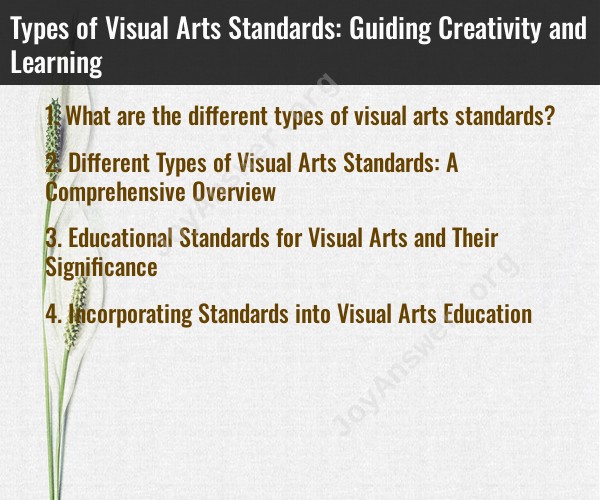What are the different types of visual arts standards?
Visual arts standards are educational guidelines that help define what students should know and be able to do in the realm of visual arts at different grade levels. These standards serve as a framework for teaching and assessing art education. Various organizations and educational institutions have developed their own sets of standards, and they typically cover a range of aspects related to visual arts education. Here are some of the common types of visual arts standards:
National Standards: In the United States, the National Core Arts Standards are widely recognized as a set of benchmarks for arts education. These standards cover four main artistic disciplines: dance, music, theatre, and visual arts. The visual arts standards include standards for creating, presenting, responding, and connecting with art.
State Standards: Many U.S. states have their own specific visual arts standards that align with or build upon the national standards. State standards may include grade-level expectations and specific learning objectives for visual arts education within that state.
International Standards: Some international organizations, such as the International Baccalaureate (IB), have established their own standards for visual arts education. These standards are used in schools and programs around the world that follow the IB curriculum.
Local School District Standards: Individual school districts may develop their own visual arts standards tailored to their specific educational goals and student populations. These standards are often aligned with state and national standards but may also incorporate local priorities.
Studio Art Standards: Studio art standards focus on the practice of creating art. They outline the skills and techniques that students should develop at different grade levels, covering areas like drawing, painting, sculpture, ceramics, and other visual art mediums.
Art History Standards: These standards emphasize the study and appreciation of art history, covering the analysis and understanding of various art movements, periods, and styles.
Aesthetic Standards: Aesthetic standards focus on the development of aesthetic awareness, helping students understand and appreciate the visual elements and principles of art, as well as the emotional and intellectual impact of art.
Media and Technology Standards: With the increasing integration of technology in art, some standards address the use of digital tools, multimedia, and new media in artistic creation.
Interdisciplinary Standards: These standards encourage the integration of visual arts with other subject areas, such as science, math, and literature, to enhance cross-curricular learning.
Cultural and Diversity Standards: These standards emphasize the exploration and understanding of diverse cultures and perspectives through art, fostering inclusivity and cultural awareness.
The specific content and organization of visual arts standards can vary from one educational context to another. They are intended to guide educators in curriculum development and help ensure that students receive a well-rounded art education that encompasses both the creation and appreciation of visual art.
Different Types of Visual Arts Standards: A Comprehensive Overview
Visual arts standards are guidelines that define the knowledge, skills, and understandings that students should develop in visual arts education. These standards are important because they provide a framework for teaching and learning in visual arts. They also help to ensure that all students have access to a high-quality visual arts education.
There are a number of different types of visual arts standards. Some of the most common include:
- National Core Arts Standards: The National Core Arts Standards (NCAS) are a set of standards that were developed by the National Art Education Association (NAEA). The NCAS are divided into four domains: Creating, Presenting/Performing/Producing, Responding, and Connecting.
- State Standards: Many states have their own set of visual arts standards. These standards are often aligned with the NCAS, but they may also include additional content that is specific to the state.
- District Standards: Some school districts have their own set of visual arts standards. These standards are often aligned with the state standards, but they may also include additional content that is specific to the district.
Educational Standards for Visual Arts and Their Significance
Educational standards for visual arts are important because they provide a framework for teaching and learning in visual arts. They also help to ensure that all students have access to a high-quality visual arts education.
Visual arts standards are beneficial for students in a number of ways. They help students to:
- Develop their creativity and critical thinking skills.
- Learn about different art forms and styles.
- Develop their artistic voice.
- Reflect on their work and process.
Visual arts standards are also beneficial for teachers. They help teachers to:
- Plan and implement effective visual arts lessons.
- Assess student learning.
- Communicate with parents and other stakeholders about the importance of visual arts education.
Incorporating Standards into Visual Arts Education
There are a number of ways to incorporate standards into visual arts education. Here are a few tips:
- Use standards to plan your curriculum. When you are planning your visual arts curriculum, use the standards as a guide. This will help you to ensure that your curriculum is comprehensive and that it covers all of the important content areas.
- Use standards to develop your lessons. When you are developing your visual arts lessons, use the standards to identify the specific knowledge, skills, and understandings that you want students to develop.
- Use standards to assess student learning. You can use the standards to develop assessments that measure student learning. This will help you to track student progress and identify areas where students need additional support.
- Communicate standards to parents and other stakeholders. It is important to communicate the standards to parents and other stakeholders. This will help them to understand the importance of visual arts education and the specific knowledge, skills, and understandings that students are expected to develop.
By incorporating standards into visual arts education, you can help all students to develop the knowledge, skills, and understandings that they need to be successful in visual arts.












